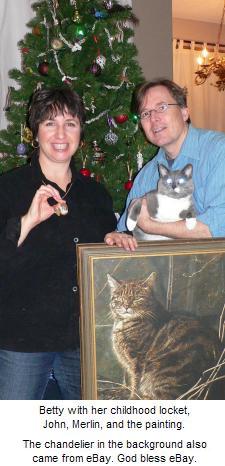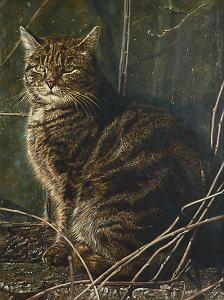 The Basic Story
The Basic Story
Elizabeth grew up in a suburb of New York City. Her father was a professional painter (Bernard Safran) who specialized in figurative and portrait painting. He was fairly successful, not to mention ridiculously talented, and in fact painted many cover portraits for Time Magazine. His work is in the collections of a variety of museums in the US and Canada.
Around 1966 he painted a really superb, larger-than-life-size oil painting of a local semi-feral cat that his family had started to care for and would eventually adopt. Elizabeth was only around six years old, but became almost as attached to the painting as to the cat itself. Safran eventually sold the painting through a Washington D.C. gallery; obviously as a working artist this is how you put bread on the table, but Elizabeth felt bereft and betrayed. In fact she still keeps a locket containing an old black-and-white photograph of that painting. That's how attached to it she was.
Now, one of the eBay tools I like to use is the auction alerts. I have a half-dozen or so searches saved, mainly particular artist names, and eBay emails me whenever a matching item comes up for auction. Bernard Safran is one of those names.
In November, I received an alert about a painting by Safran that was slated to be sold on eBay. I was somewhat surprised to see the alert, as his works don't appear anywhere that often. But when Elizabeth saw the auction listing, she was speechless. Of course, this was that same cat portrait that she had last seen 40 years before. Against all odds, it had somehow turned up at an auction house in Florida.
We agreed that we would bid on it and try to win it as a Christmas present for Elizabeth. We scoured the listing again and again for information about the painting, but this was a "live auction" and so the description was terse - just the barest details about the painting, and the ominous note: "several abrasions." Also typical for live auctions, the accompanying photograph was satisfactory but not really as good as one would like when bidding on fine art.
Elizabeth was on pins and needles, and we've suffered glitches with live auctions before, so we bid early and as high as we could justify to ourselves. Fortunately for us, the perfunctory description didn't attract high bids, and we walked away with it for just $900 (including buyer's premium).
Even better, we received the painting last week and it's in better condition than we expected, with one long but superficial scrape along the right-hand side of the painting. Some minor inpainting should make this painting as good as new, now that Babby is back in his loving home.
The Painting
The painting itself is larger than life-size and rather imposing, reflecting the personality of the cat. It's an example of Bernard Safran's usual High Realism: painting that strives to capture a scene in an extremely accurate and detailed fashion. Despite living in New York City during the heyday of such movements as Pop Art, AbEx and Minimalism, Safran returned again and again throughout his career to the study of the Old Masters - their artistic techniques, their use of materials, even their philosophical approach to painting.
It's important to note that this isn't just a picture of "a cat"; it's a portrait of an individual. In other words, it hasn't been simplified or idealized or sentimentalized or abstracted at all. It's a careful depiction of this particular cat at this moment in time, done with no less care than if the subject had been the President of the United States.
Also, contrary to what may be assumed, it is
not an example of Photorealism, for a couple of reasons:
1. Photorealism would not exist as a name or an identifiable movement for several years yet.
2. Photorealism is really a form of conceptual art, and paintings of this style are meta-conversations about the physical process of painting itself, and the role of painting in the age of photography.
In fact, if you look at a
close-up detail of the painting, you can clearly see painterly effects such as tiny parallel brushstrokes that give shading and shape to the cat's face.
Babby's Story
 by Elizabeth Malyon
by Elizabeth Malyon
One of my first memories is toddling down to a neighbor's house with my mother to see a new litter of kittens in a box behind their kitchen stove. I was probably less than two years old myself, and Babby the cat was only days old. Babby was eventually adopted into a family across the street from us that had a rambunctious dog and two equally rambunctious kids. The cat was not happy at his first home. This was when Babby started visiting our house.
He would come over and sit in the garden when my mother was weeding; he would visit in the summer when we sat outside; he would climb up our kitchen screen door and watch us eat dinner - this was how we discovered he had a spotted belly. Eventually, he would come into the house to visit and I would come home from school for lunch and find him sleeping on my bed. I remember him being in my room when my mother and sister and I watched Star Trek and the Ed Sullivan show in the evenings.
He was not a cuddly cat by any means - he was fierce, and dangerous if touched and very independent. Despite numerous scratchings from the cat, I loved him dearly. Babby changed owners at least two more times and lived as a feral cat for long periods of time while we were living there. My father did not want to take him in and we were not allowed to feed him. But he must have turned a blind eye to the cat's visits, as Babby kept coming to see us for at least 10 years.
In 1972, my parents decided to leave suburban New York City and move to rural Eastern Canada, an area where my mother had relatives. My sister and mother and I were all heartbroken about leaving Babby. Though we had not fed him or cared for him for 10 years we had loved him and helped him when we could. His current owners were away in Europe for several months and they had just left the cat to fend for himself. He was starving and living on birds and mice and whatever he could scrounge. Our next-door neighbor was shooting at him with a slingshot whenever Babby ventured into his yard.
So my sister and I (then aged 12 and 17 respectively) went down into New York City by ourselves to go to the Canadian consulate to see if we could bring the cat with us. I remember the staff were very amused by our strained and worried expressions and the journey we had undertaken to try and save this cat. Luckily they told us that at that time there were no restrictions on cats entering Canada so we were free to bring him. We presented this to our father who relented when he saw our pleading faces and Babby finally became one of the family.
Babby lived another 9 years with us on the farm in New Brunswick. Once he was with us permanently he relaxed and became an affectionate, loving animal. My father even came round to him, and when he thought no one was around he would talk to Babby and pat him and excuse him from being on the kitchen table.
Babby was quite a well-documented cat -- a painting of him by my mother, Adele Safran, can also be seen online (see link below). That painting has a softer, Matisse/Steinlen/Post-impressionist feel to it. My father captured Babby in one of his feral periods - fierce, independent, fluffed against the cold - a hunter and a wild cat no one would mess with. He was so tough I remember him taking on a dog and winning. Of course, later in his life, when he retired to the country, he became a real pussycat.
Links (These links open in a new window)

 The Basic Story
The Basic Story